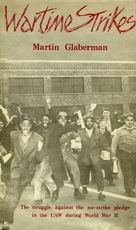
Wartime Strikes
The struggle against the no-strike pledge in the UAW during World War II
Glaberman, Martin
Publisher: Bewick/ed, Detroit, USA
Year Published: 1980
Pages: 158pp ISBN: 0-935589-11-0
Resource Type: Book
Cx Number: CX7721
The history of the struggle against the no-strike pledge in the United Auto Workers of America (UAW) and the organization of the Rand and File Caucus, accompanied by an analysis of the question of working class consciousness in the light of this experience. Glaberman asks: What is the nature of working class consciousness and how does it relate to the question of whether the working class has the capacity to transform modern society?
Abstract:
Martin Glaberman's Wartime Strikes offers a view into an aspect of American history seldom discussed in relation to the Second World War. The domestic economic history of the United States during the 1940s is more often viewed in relation to the rapid recovery and growth of the economy from the depression of the 1930s rather than through the experiences of workers, unions and labour representatives. Strikes are not often discussed, although as Glaberman highlights, there were more than fifteen thousand strikes in the manufacturing industry during the war alone. Production of war materials was essential to the success of operations overseas, but the demands and restrictions placed on workers unleashed waves of discontent and disruptions in the factories.
After the Japanese attack on Pearl Harbour, President Roosevelt set up a meeting with leaders of labour and industry to formulate a policy that would "prevent the interruption of production by labor disputes during the period of the war". The meetings led to three resolutions: "There shall be no strikes or lockouts. All disputes shall be settled by peaceful means [and] The President shall set up a proper War Labor Board to handle these disputes". Glaberman's work discusses the interaction between labour and industry revealing the various elements contributing to the strikes between 1941 and 1945. Although many union representatives pledged a no strike policy, the circumstances and burdens placed workers in a difficult position and caused a series of strikes throughout the war.
Glaberman breaks his work down into seven chapters documenting the various groups involved on both sides of the picket lines. From union and labour leaders, wildcat strikers and left-wing political activists to industry representatives and the role of the government, the book aims to present a rounded understanding of the events impacting American production industries during the war. Wartime Strikes focuses the majority of its attention on the auto sector. The United Auto Workers (UAW) union pledged a no strike policy, but union members nonetheleess went out on strike when their concerns were ignored. Glaberman uses government records and investigations of wartime strikes, recollections of union activist, union proceedings and information from newspapers to reconstruct the atmosphere during the wartime years. The author "has recreated both the nature of shop floor controversies and group loyalties which produced the strikes and the political history of the conflict within the union over the continuation of the [no strike] pledge." Wartime Strikes presents a significant contribution to American labour history, bringing to light the struggles and determination of workers to ensure their own rights in the face of a global war and government and union constraints.
[Abstract by William Stevenson]
Table of Contents
Forward
1. Taking the Pledge
2. Changes in the Labor Force
3. Wildcats
4. Role of the Left
5. Mechanics and Miners
6. Culmination and Contradiction
7. Conclusions
Reference Notes
Bibliography
Index
Subject Headings


